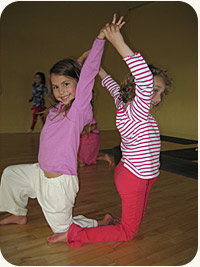“People ask me, Can kids do yoga?” says April Cantor, who teaches tots at Bend & Bloom.
“And I say, They already do!”
In fact, yoga is a natural for kids, from the obvious Child’s Pose (balasana), Happy Baby (ananda balasana, meaning blissful baby) on to Down and Up Dog, which, as anyone watching infants and toddlers knows, are movements kids do as they develop.
“They’re teaching me,” says April. “I see these one to three-year-olds doing cobra or downward dog without even a thought. When I say there’s a name for what they do, I see them light up.”
Appealing to children’s universal love of animals are Frog, Lion, Cat, Cow and Dolphin. These poses come from nature, and kids arrive in our lives trailing the vines and leaves of the wild behind them. As they grow, yoga provides an outlet for their explosive energy and has much to offer the young mind and body.
Kid-friendly Brooklyn has a breadth of classes bringing this ancient practice into all phases of a child’s life. New parents aching for a little exercise can find Mommy & Me classes at several studios in the Slope, and, as children’s needs evolve, there are classes for every age, from tots to tweens to teens. On Saturdays, there are several studios where a whole family can jump into practice together.
With yoga, kids learn to manage their bodies and develop strength, coordination, flexibility and courage. They refine their observation skills as they learn yoga’s range of twists, bends and balances. Taught by dynamic, inventive teachers with varied backgrounds in dance, fitness and theater, yoga can appeal to their imaginations. They can also learn the power of silence, with simple ways to calm—the mind-coping skills from which we can all benefit.
From my years of teaching nursery school and dance to kids, I know that when you teach children, whatever the subject—clay, guitar, art, ceramics, math, writing or dance—you’re teaching values. Yoga, with its roots in contemplation and guidelines for attitudes and personal conduct, articulates those values. The philosophy inherent in yoga practice really can work for all ages.
Jennifer Brilliant’s studio on the ground floor of her brownstone on Carroll Street has brightly colored walls painted on one side with the sun, on the other, the moon. The day I observed two classes, teacher Sarah Seely, had just returned from a trip to Barbados where she had tried something completely new: surfing!
Building her class around its elements, she asked the kids what might be required for this challenging sport, and they answered: balance, determination, stability, focus, confidence and calm. Balance on moving water, courage to do something new, determination to persist through an awkward beginning and observation of the movements of the ocean.
Grouped in pairs, each child came up behind a partner and gave a gentle shove. The foot that came forward as the partner lost and regained balance determined which one should lead on the surfboard. Sarah then broke down the activity into its moving parts: paddling out, with each child’s mat doubling as his or her own board; up dog (urdhva mukha svanasana), to watch and sense the coming wave, a twist as you follow that wave and align the board to the surf, and then a jump from up dog to standing on both legs at once—a tough move.
I watched their ragged first attempts smooth out until there they were, ready to ride the wave. From this, they can see how yoga isn’t some group of arbitrary positions you do indoors, but a functional vocabulary alive in a real sport.
Yoga classes are a great opportunity to develop confidence. Sarah led a discussion among the teens.
“What have you tried,” she asked, “that first was scary, then got easier, and then was fun?”
One talked about diving, another about the terrors of sleepaway camp, another about swimming with sharks in France. Heavens, these Brooklynites are world travelers.
There were plenty of physical challenges in Sarah’s warm-up—five squats on one leg, holding boat pose—navasana, an abdominal feat—for a long series of counts.
“This has nothing to do with surfing,” said one boy.
A girl collapsed on the floor.
Another protested, “My arms hurt.”
Jennifer assisted, offering individual attention to focus a kid who’s distracted or needs extra help. A cell phone rang; someone didn’t turn hers off. Whatever the age, a teacher of children is defying entropy, the barely contained chaos that presses against the boundaries of every classroom. Against those odds, these teenagers learn to practice bramacharya—impulse control—an element essential to the harmony of the group.
Toddlers have no clue about a group.
“They’re going to wander,” says April, “and anyone teaching tots has to be okay with a little bit of chaos.”
She reels them in with music, giving them flight paths for their energy.
“We’ll make our arms like airplanes and fly to one part of the room. Then we fly in triangle pose, because that’s how pilots fly their planes. Sequences are really creative movement. We can do a whole vinyasa flow.”
What a child absorbs in a yoga class may not seem obvious. All these teachers mentioned the indirect way children integrate what they’ve learned.
“Even when you think they’re not really paying attention or haven’t quite grabbed it,” said Sarah, “something pops out of their mouths later, and I can see they’ve absorbed a lot. I’m so proud and inspired when I realize, ‘Oh you were listening.’”
The same is true of the tiny yogis. April builds her drop-in classes at Bend & Bloom to include the parents and caregivers who accompany the kids to class. She tells them not to worry if their children don’t seem to be participating. Most often, “they want to observe it first,” she says. “Then they go home, remember it, and do the whole class.” When parents return, they tell her, “You know, you’re right. Just before bed, they want to do yoga to help themselves calm down.”
Among yoga’s essential tools are conscious breath and meditation. One teenager at Jennifer’s studio said she uses meditation to calm her nerves before a test; another waiting nervously with her cast members backstage before a dance performance shared a few minutes of quiet meditation and said, “It actually really helped.”
To teach kids about breath, April will produce a pinwheel for them to blow.
“I’ll use feathers so they can watch the feathers dance in the wind they make. They start to understand the elements—earth, water, wind—and how they’re part of this earth, part of nature.”
Believe it or not, when their imagination is engaged, little children can learn to meditate. Everyone in April’s class wanted to be a car when the theme was transportation.
So, at the end, she said, “Okay, let’s be the best parked cars we can be. We turn off our engines, we keep breathing. We close our doors, we shut off our headlights—we close our eyes—and when I ring the bell, I’m going to count to ten or fifteen, and all you have to do as a well-parked car is to breathe softly and to listen to my counts.”
They may sit with their eyes closed for ten seconds. Sometimes she’ll make it up to thirty or sixty. Over a few years, she can get these little ones to sit in meditation for up to a minute and a half, which is more than some of us grown-ups can do.
All these teachers aim to convey compassion to their students.
“Kindness and respect is paramount,” said Sarah. “When you’re a kid, it’s so easy to be in the sphere of your own experience. But I want them to know how their actions affect those around them. I tell them to pay attention. It’s not just about your phone and what your friends are up to. There’s a lot more going on in the world.”
On the tot level, April has an age-appropriate way to teach about compassion.
“I did a class on dinosaurs,” she recalls, “and I brought out a stuffed T-Rex that looks kind of mean, very fierce. Some kids were afraid of the doll, so they’d hug it and pass it on. And I said, ‘Sometimes someone who’s acting mean and looks mean needs some kindness. They really just need a hug and, and their real self will come out.’ And they get it, even at that age.”
“What’s most important to me,” said Jennifer Brilliant, who has offered kids classes at her studio the Park Slope for ten years, “is that they learn to like themselves, that they see how they can improve over time, in their own body, their own mind. I want them to learn how to treat others, but also develop a deeper relationship with themselves.”
Kids classes look different from those for adults. They may have songs, dancing, animals, sports and games, but the underlying elements are all there. Observing kids’ classes and talking with their teachers has shown me—as a lifelong practitioner and yoga teacher—how yoga can both ease and empower us in each phase of our walk through life.
Love elephant and want to go steady?
Sign up for our (curated) daily and weekly newsletters!
Apprentice Editor: Brandie Smith / Editor: Renée Picard
Photo: heidelknips/Flickr, jseattle/Flickr













Read 0 comments and reply